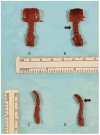Lubricin deficiency in the murine lumbar intervertebral disc results in elevated torsional apparent modulus
- PMID: 25907550
- PMCID: PMC4492848
- DOI: 10.1016/j.jbiomech.2015.03.029
Lubricin deficiency in the murine lumbar intervertebral disc results in elevated torsional apparent modulus
Abstract
The purpose of this study was to investigate the mechanical consequences of proteoglycan 4 (Prg4) deficiency on intervertebral disc mechanics using a Prg4 knockout mouse model. Prg4, also called lubricin, was first identified as the boundary lubricant in synovial fluid but has subsequently been localized within a number of musculoskeletal tissues in areas subjected to shear and tensile stresses, including the intervertebral disc. The function of lubricin in the intervertebral disc has not been determined. Lumbar level 1-2 vertebral body-disc-vertebral body motion segments were isolated from Prg4 null mice and wild type (WT) litter mate controls. Disc dimensions were measured and motion segments were tested in axial loading and torsion. Torque measurements and disc dimensions were used to calculate the torsional apparent modulus for discs from Prg4 null and WT discs. Discs from Prg4 null mice had a significantly smaller mean transverse disc area (p=0.0057), with a significantly larger proportion of this area occupied by the nucleus pulposus (p<0.0001), compared to WT specimens. Apparent torsional moduli were found to be elevated in Prg4 null lumbar discs compared to WT controls at 10-10° (p=0.0048) and 10-30° (p=0.0127) rotation. This study suggests a functional role for Prg4 in the murine intervertebral disc. The absence of Prg4 was associated with an increased apparent torsional modulus and the structural consequences of Prg4 deficiency in the intervertebral disc, with expansion of the area of the nucleus pulposus relative to the transverse disc area in Prg4 null specimens.
Keywords: Apparent torsional modulus; Disc; Lubricin; Prg4; Proteoglycan 4.
Copyright © 2015 Elsevier Ltd. All rights reserved.
Conflict of interest statement
Figures



Similar articles
-
Altered disc mechanics in mice genetically engineered for reduced type I collagen.Spine (Phila Pa 1976). 2004 May 15;29(10):1094-8. doi: 10.1097/00007632-200405150-00009. Spine (Phila Pa 1976). 2004. PMID: 15131436
-
Effects of degeneration on the elastic modulus distribution in the lumbar intervertebral disc.Spine (Phila Pa 1976). 1996 Apr 1;21(7):811-9; discussion 820. doi: 10.1097/00007632-199604010-00007. Spine (Phila Pa 1976). 1996. PMID: 8779011
-
Rat disc torsional mechanics: effect of lumbar and caudal levels and axial compression load.Spine J. 2009 Mar;9(3):204-9. doi: 10.1016/j.spinee.2008.01.014. Epub 2008 May 20. Spine J. 2009. PMID: 18495544 Free PMC article.
-
Spinal biomechanics and aging are major determinants of the proteoglycan metabolism of intervertebral disc cells.Spine (Phila Pa 1976). 2000 Dec 1;25(23):3014-20. doi: 10.1097/00007632-200012010-00008. Spine (Phila Pa 1976). 2000. PMID: 11145812
-
Is the nucleus pulposus a solid or a fluid? Mechanical behaviors of the nucleus pulposus of the human intervertebral disc.Spine (Phila Pa 1976). 1996 May 15;21(10):1174-84. doi: 10.1097/00007632-199605150-00009. Spine (Phila Pa 1976). 1996. PMID: 8727192 Review.
Cited by
-
Regulation of terminal hypertrophic chondrocyte differentiation in Prmt5 mutant mice modeling infantile idiopathic scoliosis.Dis Model Mech. 2019 Dec 17;12(12):dmm041251. doi: 10.1242/dmm.041251. Dis Model Mech. 2019. PMID: 31848143 Free PMC article.
-
Proteoglycan Dysfunction: A Common Link Between Intervertebral Disc Degeneration and Skeletal Dysplasia.Neurospine. 2024 Mar;21(1):162-178. doi: 10.14245/ns.2347342.671. Epub 2024 Mar 31. Neurospine. 2024. PMID: 38569642 Free PMC article.
-
Transcriptomic profiling reveals key early response genes during GDF6-mediated differentiation of human adipose-derived stem cells to nucleus pulposus cells.JOR Spine. 2024 Jan 19;7(1):e1315. doi: 10.1002/jsp2.1315. eCollection 2024 Mar. JOR Spine. 2024. PMID: 38249721 Free PMC article.
-
Biomimetic Proteoglycans for Intervertebral Disc (IVD) Regeneration.Biomimetics (Basel). 2024 Nov 22;9(12):722. doi: 10.3390/biomimetics9120722. Biomimetics (Basel). 2024. PMID: 39727726 Free PMC article. Review.
-
Superficial zone cellularity is deficient in mice lacking lubricin: a stereoscopic analysis.Arthritis Res Ther. 2016 Mar 14;18:64. doi: 10.1186/s13075-016-0967-4. Arthritis Res Ther. 2016. PMID: 26975998 Free PMC article.
References
-
- Bahabri SA, Suwairi WM, Laxer RM, Polinkovsky A, Dalaan AA, Warman ML. The camptodactyly-arthropathy-coxa vara-pericarditis syndrome: clinical features and genetic mapping to human chromosome 1. Arthritis and rheumatism. 1998;41:730–735. - PubMed
-
- Elliott DM, Sarver JJ. Young investigator award winner: validation of the mouse and rat disc as mechanical models of the human lumbar disc. Spine. 2004;29:713–722. - PubMed
-
- Elsaid KA, Jay GD, Chichester CO. Reduced expression and proteolytic susceptibility of lubricin/superficial zone protein may explain early elevation in the coefficient of friction in the joints of rats with antigen-induced arthritis. Arthritis and rheumatism. 2007;56:108–116. - PubMed
-
- Faivre L, Prieur AM, Le Merrer M, Hayem F, Penet C, Woo P, Hofer M, Dagoneau N, Sermet I, Munnich A, Cormier-Daire V. Clinical variability and genetic homogeneity of the camptodactyly-arthropathy-coxa vara-pericarditis syndrome. American journal of medical genetics. 2000;95:233–236. - PubMed
Publication types
MeSH terms
Substances
Grants and funding
LinkOut - more resources
Full Text Sources
Other Literature Sources
Miscellaneous

